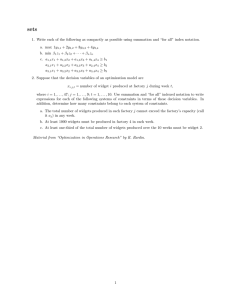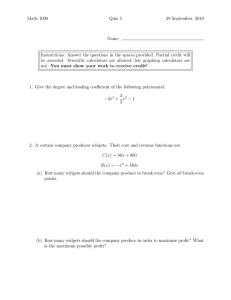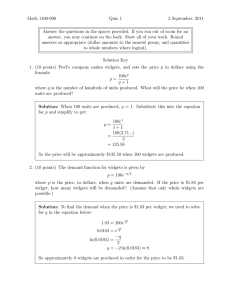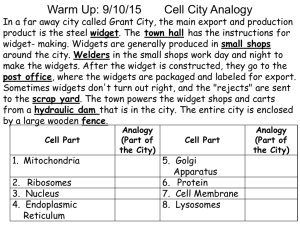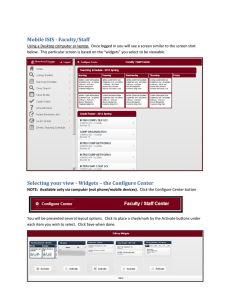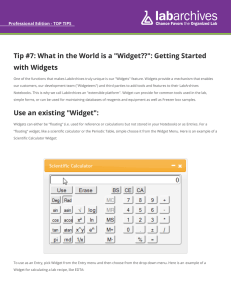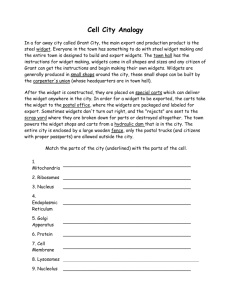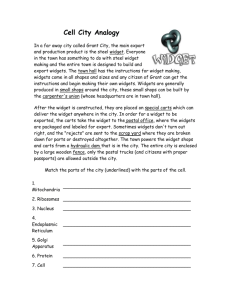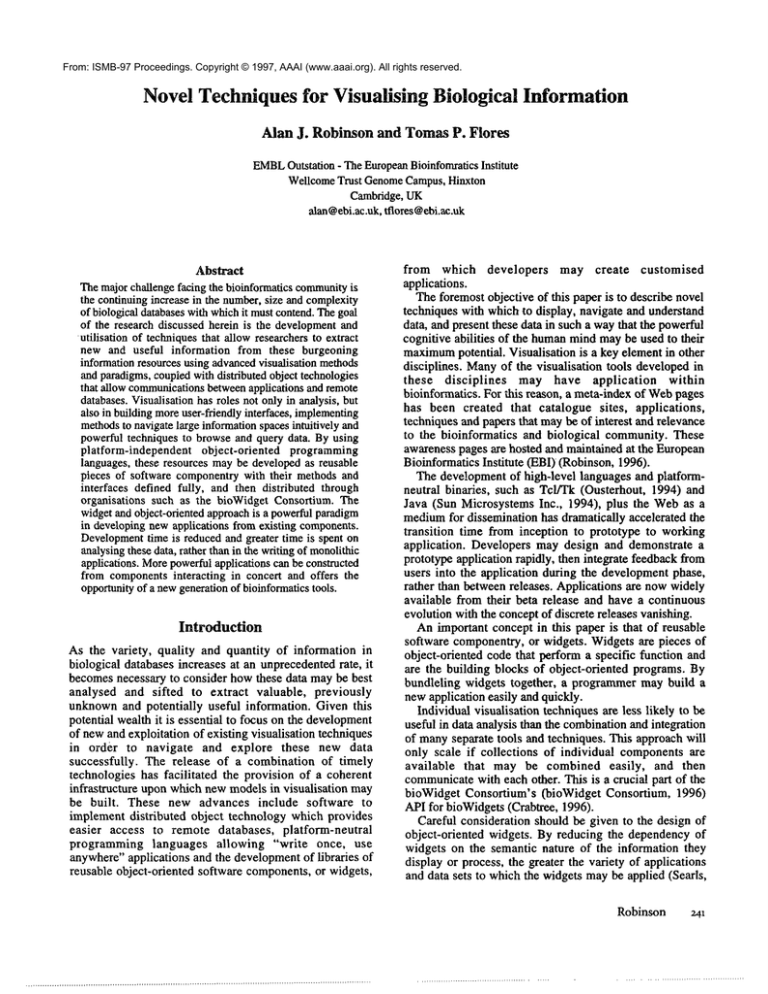
From: ISMB-97 Proceedings. Copyright © 1997, AAAI (www.aaai.org). All rights reserved.
Novel Techniquesfor Visualising Biological Information
Alan J. Robinson and TomasP. Flores
EMBL
Outstation - TheEuropeanBioinfomraticsInstitute
WellcomeTrust GenomeCampus,Hinxton
Cambridge, UK
alan@ebi.ac.uk,tflores@ebi.ae.uk
Abstract
The majorchallengefacing the bioinformaticscommunity
is
the continuingincrease in the number,size and complexity
of biologicaldatabaseswith whichit mustcontend.Thegoal
of the research discussed herein is the developmentand
utilisation of techniquesthat allow researchersto extract
new and useful information from these burgeoning
informationresourcesusing advancedvisualisation methods
and paradigms,coupledwithdistributed object technologies
that allow communications
betweenapplications and remote
databases.Visualisationhas roles not onlyin analysis, but
also in buildingmoreuser-friendlyinterfaces, implementing
methodsto navigatelarge informationspacesintuitively and
powerful techniques to browseand query data. By using
platform-independent object-oriented programming
languages, these resources maybe developedas reusable
pieces of software componentrywith their methodsand
interfaces defined fully, and then distributed through
organisations such as the bioWidget Consortium. The
widgetand object-oriemedapproachis a powerfulparadigm
in developingnewapplications fromexisting components.
Development
time is reducedand greater time is spent on
analysingthese data, rather than in the writingof monolithic
applications. Morepowerfulapplicationscan be constructed
from componentsinteracting in concert and offers the
opportunityof a newgenerationof bioinformaticstools.
Introduction
As the variety, quality and quantity of information in
biological databases increases at an unprecedentedrate, it
becomesnecessary to consider how these data maybe best
analysed and sifted to extract valuable, previously
unknownand potentially useful information. Given this
potential wealth it is essential to focus on the development
of newand exploitation of existing visualisation techniques
in order to navigate and explore these new data
successfully. The release of a combination of timely
technologies has facilitated the provision of a coherent
infrastructure upon which newmodels in visualisation may
be built. These new advances include software to
implement distributed object technology which provides
easier access to remote databases, platform-neutral
programming languages allowing "write once, use
anywhere"applications and the developmentof libraries of
reusable object-oriented software components,or widgets,
from which developers
may create
customised
applications.
The foremost objective of this paper is to describe novel
techniques with which to display, navigate and understand
data, and present these data in such a waythat the powerful
cognitive abilities of the humanmind maybe used to their
maximum
potential. Visualisation is a key element in other
disciplines. Manyof the visualisation tools developed in
these disciplines
may have application
within
bioinformatics. For this reason, a recta-index of Webpages
has been created that catalogue sites, applications,
techniques and papers that maybe of interest and relevance
to the bioinformatics and biological community. These
awareness pages are hosted and maintained at the European
Bioinformatics Institute (EBI) (Robinson,1996).
The deve!opmentof high-level languages and platformneutral binaries, such as Tcl/Tk (Ousterhout, 1994) and
Java (Sun Microsystems Inc., 1994), plus the Webas
mediumfor dissemination has dramatically accelerated the
transition time from inception to prototype to working
application. Developers may design and demonstrate a
prototype application rapidly, then integrate feedbackfrom
users into the application during the developmentphase,
rather than between releases. Applications are nowwidely
available from their beta release and have a continuous
evolution with the conceptof discrete releases vanishing.
An important concept in this paper is that of reusable
software componentry, or widgets. Widgets are pieces of
object-oriented code that perform a specific function and
are the building blocks of object-oriented programs. By
bundleling widgets together, a programmer may build a
newapplication easily and quickly.
Individual visualisation techniques are less likely to be
useful in data analysis than the combinationand integration
of manyseparate tools and techniques. This approach will
only scale if collections of individual componentsare
available that may be combined easily, and then
communicatewith each other. This is a crucial part of the
bioWidget Consortium’s 0aioWidget Consortium, 1996)
APIfor bioWidgets(Crabtree, 1996).
Careful consideration should be given to the design of
object-oriented widgets. By reducing the dependency of
widgets on the semantic nature of the information they
display or process, the greater the variety of applications
and data sets to which the widgets maybe applied (Searls,
Robinson
24x
1995a; Searls, 1995b). The principles of object-oriented
programmingwere devised to foster the reuse of code, and
encapsulation plays a central role in ensuring this goal.
Widgets are designed to encapsulate a well-defined
behaviour. Understandingof their internal implementation
details is not required. Instead widgets are integrated
through interfaces.
By defining widgets with robust
interfaces and inter-operability
in mind, it becomes
tractable to plug combinationsof these widgets together in
a coherent mannerand build applications with functionality
beyondthat conceived initially by the widget’s developer
(Stein, Rozen and Goodman, 1994; Goodman,Rozen and
Stein, 1995). As a consequenceof this, the proportion of
time a developer has to spend in prototyping and testing
code is reduced significantly.
By abstracting
the
implementationfrom the semantics of the data, it is then
the core code, or "widget glue" that binds the widgets
together, and provides the specialisation whichdefines the
nature of the application.
time and the numberof lines of code needed to be written
by a programmer.As the data are brought back from the
server, they are used to construct a tree that is displayed
using a hyperbolic projection in an applet window(see
Figure 1). The hyperbolic projection viewer and its
componentwidgets were written as a contribution to the
bioWidget Consortium’s effort to provide high-quality,
reusable componentry of benefit and use to the
bioinformatics and biological community (bioWidget
Consortium, 1996).
’Focus+Context’ Displays
Animportant visualisation concept is the ’focus+context’
paradigm. The philosophy behind this approach is that
while a user focuses upon a subset of their data, they
should retain a sense of its context within the global
scheme. This provides not only a meansto navigate rapidly
and conveniently through large, complexdata sets, but also
to observe both short and long range correlations and
patterns in data simultaneously and their possible interrelationship. A real world exampleof a ’focus+context’
view is a fisheye camera lens. Pictures taken with such
cameras have an extremely wide field of vision. At the
centre of the image, the view is highly magnified while
movingtowards the periphery, objects diminish rapidly in
size.
An example of such a ’focus+context’
viewer for
displaying data is the hyperbolic projection view which
mapspoints into hyperbolic space and displays them as a
2-D representation. Analysis of data using hyperbolic space
was developedinitially as a meansto layout and visualise
large tree structures in an intuitive manner(Lampingand
Rao, 1994; Lamping, Rao and Pirolli, 1995), allowing the
user to both examinea section of tree nodes without losing
their sense of position within the tree, and navigate through
the tree intuitively.
Within bioinformatics, the most obvious application of
the hyperbolic projection principle is in the display of
phylogenetic information.
The taxonomy database
maintained by the National Center for Biotechnology
Information (NCBI) reflects
current phylogenetic
knowledgeand is, as far as is possible, a sequence-based
taxonomyusing published authorities. An application has
been written that allows users to query and browse these
data and uses a hyperbolic projection to display the
resulting phylogenetic tree. The application exemplifies
both the use of reusable componentry and distributed
object technology in order to reduce both the development
242
ISMB-97
Figure 1: A hyperbolic projection of a phylogenetic tree
that illustrates the ’focus+context’ technique. Objects
toward the perimeter of the view are reduced in size, while
those in the centre are magnified. The applet may be
downloadedfrom http://sunny.ebi.ac.uk/EBI/BioWidget/
Widgets maybe divided roughly into graphical and nongraphical widgets. Graphical widgets possess methods to
display information in a graphical context. Non-graphical
widgets encompassother functionality, e.g. they mayeither
process and operate on information, or provide a data
modelfor the storage of information. The applet illustrated
in Figure 1 is comprised of four separate widgets, each of
which could be reused in other applications, plus the
component code that binds them together.
The
HyperCanvas
widget is a graphical widget that provides the
canvas upon which the objects are drawn and an easier
front-end to the Converter non-graphical widget which
maps coordinates from their hyperbolic plane coordinate
systemto that of the screen, and from screen to hyperbolic
plane. The Tree non-graphical
widget provides a
mechanism
to store the data structure of the tree and access
and query its elements. Althoughthe Tree widget contains
methodsto calculate the layout of tree structures, it is not a
graphical widget as it does not include methodsto write to
the screen. Finally there is the TaxonomyServernongraphical widget which provides the methods to query the
remote taxonomy server and hides all the code that is
necessary to access the database over the network. This
allows the database to be treated as if it werea local object
to be queried. The accessing of the database is done
through interfaces
provided by implementing CORBA
(The Object ManagementGroup and X/Open, 1992).
The architecture of the application is such that the Tree
widget provides the means to store the data modelof the
tree which is constructed from entries retrieved by the
TaxonomyServer widget. The graphical HyperCanvas
displays the tree by accessing the data stored in the Tree
widget through the Converter object which converts the
actual positions of the tree nodesinto a screen position. In
this way, the graphical HyperCanvas object remains
abstracted from the semantics of the data in the Tree
widget. Communication between the widgets is
orchestrated by the componentcode that binds the widgets
together and provides the control interfaces.
The HyperCanvas and Converter widgets are not
dependent upon semantic detail and thus may be used to
project any data, provided it has somenotion of its position
in space. The Tree widget is more dependent on semantics
and the nature of the data it describes. Howeverthe basic
Tree widget maybe extended to provide this functionality.
This abstraction of the widget implementation from the
semantics of the data facilitates greater reuse of the
widgets. By reusing widgets, a developer mayconcentrate
their efforts uponproviding the application functionality,
rather than implementation details of individual
components.
The Display of Large Information Spaces Information Murals
A drawback of the hyperbolic projection ’focus+context’
approach is that the coordinate space of the points is
distorted during the projection into hyperbolic space. A
user might wish to examinethe complete data set without
focusing in upon a particular portion in order to view the
spatial relationship, e.g. clustering or distance, between
points. This will be hamperedby the distortion of the data
space. A technique is required to examinelarge data sets
that may contain more data points than there are screen
pixels available. Information murals (Jerding and Stasko,
1995a; Jerding and Stasko, 1995b; Jerding and Stasko,
1996) address this challenge by using graphics aliasing and
anti-aliasing techniques. At its simplest, an information
mural treats a screen pixel as a histogram bin into which
data points are collected. The intensity of each pixel when
displayed is proportional to the numberof points that have
fallen within its bin. This technique adds extra information
to scatter plots since clusters of pixels containing many
data points will appear brighter than similarly sized clusters
madeup of fewer points.
To illustrate the application of information murals,
Figure 2 showstwo scatter plots displaying the percentage
sum of guanine and cytosine content along a DNA
sequence 0.6 megabaseslong. Regions rich in guanine and
cytosine are usually taken to indicate the possible location
of genes. The percentage sum was calculated every 50
bases by averaging over the next 200 bases. Thus the
informational mural is attempting to describe over 12,000
data points in the display area. For comparison, a
conventional monochromeplot where a pixel is drawn for
every data point is shown below the plot using an
information mural (N.B. A blue to red colour scheme was
used in the actual plot so as to increase the contrast
between pixels). Fromthe information mural depiction, it
can be ascertained which peaks correspond to a longer
length of the DNAshowing a high combined guanine and
cytosine content, and not just localised, or spurious, points.
The former will occur as bright points, and the latter as
dimmer objects. This information is missing from the
conventional scatter plot. Using an information mural has
increased the information content of the display without
complicatingit significantly.
Figure 2: Twodifferent displays of the combinedguanine
and cytosine percentage content along a DNAsequence 0.6
megabases long. a) The information presented using an
information mural b) The same information in a normal
scatter plot.
The code to generate the information murals was written
in Java and is thus object-oriented and readily reusable.
Furthermore its methodsare designed not to be dependent
upon the semantic nature of the data. The information
mural widget has already been used in a range of varied
applications, e.g. the display of feature mapsof long DNA
sequences from the EMBLNucleotide Sequence database
as well as to show average base composition. The
applications have also included zoomable information
murals that allow users to magnifyand examineinteresting
Robinson
......... ... ...........................................................................................................................................................................................................
243
... ..........................................................
regions in more detail. Information murals are a technique
that should have a wide application in manyfields and not
just bioinformatics. The technique maybe extended to 3-D
projections using voxels, the 3-D equivalent of pixels,
where clusters of points in space would appear as bright
"constellations".
Visualising Semantic Information - Semantic
Lenses and Filters
The data that are to be analysed in bioinformatics are often
rich in semantics, e.g. a single SWISS-PROT
or EMBL
Nucleotide Sequence entry contains large amounts of
information. This necessitates techniques which will allow
users to filter data and only examinethose data, or part of
themthat are of interest. This requires methodsthat operate
upon the semantics of these data and hence involves
designing widgets which, rather than being general, are
instead easily extensible to support all possible types of
behaviour. Just as ordinary lenses or filters can magnify
and change the appearance of objects beneath them, so an
ideal tool wouldbe a lens or filter which wouldfocus or
filter informationintrinsic to the data points beneaththem.
Such tools are called semantic lenses and filters (Bier, et
al., 1993; Stone, Fishkin and Bier, 1994) and in an entirely
analogous fashion to regular lenses, semantic lenses may
be overlaid to producequite complicatedlenses, or queries.
To a certain extent, semantic lenses incorporate the
’focus+context’ ideology.
Figure 3 shows the implementation of some semantic
lenses operating on data points within a graph. The basic
lens has been written to be fully extensible, allowing
developers to design and implementspecialised behaviour
for their lenses in a straightforward manner. Furthermore,
lenses do not have to be simple data filters, they mayalso
operate upon the underlying data. Thus lenses could be
conceived of that implementgene prediction behaviour. If
several of these lenses, each implementing different
algorithms are overlaid and passed over a DNAsequence,
then a consensus view may be displayed that highlights
those regions most likely to correspondto genes.
The current semantic lenses were implemented in Java
during an effort to clarify the presentation of the
relationship between a group of protein entries from the
SWlSS-PROTdatabase. The data were homology scores
from BLASTsequence comparisons between pairs of
proteins from a set of forty-nine proteins. These scores
were then used in a geometric minimisation such that those
proteins showing greater homology to each other were
placed closer together in space.
Originally, the data points of Figure 3 had been shown
as points in 3-D space (see Figure 4), howeverthis scene
turned out to be both difficult and slow to navigate with
users getting lost because of the unsuitability of computer
screens in showing3-D data and the loss of context whena
viewer zoomedinto a scene. So a 2-D approach was tried
using semantic lenses (see Figure 3). The images of Figure
3 show that the applet uses a ’focus+context’ type
244 ISMB-97
philosophy, also called ’pan and zoom’. In the top level
windowall the data points are shownwith the output of the
lens within it directed to a daughter windowthat showsan
enlarged view of these data. It is howevereasy to maintain
howthe zoomedview relates to the overall scene because
the position of the daughter lens is shownclearly in the
parent. Figure 3 also illustrates howlenses in the daughter
windowmay be overlaid; one lens shows the name of the
organismthat the protein originated from, the other shows
the SWISS-PROT
entry name of the protein. Where these
lenses are overlaid, both names are shownfor underlying
points.
©
:/10
-IIg :0
(..~0
©
Figure 3: An implementation of semantic lenses being
applied to data points corresponding to SWISS-PROT
entries. The parent windowcontains a single lens, the
output of which is directed to the daughter windowwhich
contains two further semanticlenses. (See text for details).
An example applet implementation of semantic lenses may
be downloaded from http://industry.ebi.ac.uk/~alan/
SemanticLenses/
Using the 2-D ’pan and zoom’ parent and daughter
windowapproach, plus the power of semantic lenses, both
navigation and comprehension of the data becomes more
intuitive. Theseare extremely important considerations in
the design of any user interface or application. There is no
reason why semantic lenses could not be applied to 1-D
data, e.g. DNAand protein sequences, to 3-D data where
the lens iseither a 2-D windowoperating on data behind it,
or a 3-D shape that acts uponpoints contained within it, or
a lens that is placed over other widgets, e.g. information
murals. For the last option to be feasible, communication
between widgets is essential which implies they must have
a commoninterface to handle events between them. Such
an interface is part of the bioWidgetAPI.
~:~:: " :.:::: .:~i:i:i:.
’’""::::::" ......
applications, or to use the application itself (which may
require its further development).
By way of an example, the program MapViz, which is
part of the MineSetdata mining suite of packages produced
::::::::::::::::::::::::::::::::::::::::::::::::::::::::::::::::::::::::::::::::::::::::::::::::::::::::::::::::::::::::::
by Silicon Graphics Inc. (SGI)(Silicon Graphics Inc.,
1996), is used normally to display the geographical and
spatial relationships of data, e.g. the spending per
household in States of the USAwould be shownas a map
of the USAwith the height of each state corresponding to
expenditure. Howeverthe principle mayalso be applied to
genomicdata, i.e. the geographic mapmaybe replaced by
a genomic map. This effort was a collaboration between
the EBI and SGI. SGI converted the raw data provided by
the EBI into a suitable format for integration into the
MapVizapplication.
Figure 4: A 3-D non-linear map of the SWISS-PROT
entries from Figure 3 shown using VRML.This may be
downloadedfrom http://industry.ebi.ac.uk/-alan/VRMI./
This simple example shows how lenses have been
implemented that deal with points whose semantic
information relates to SWISS-PROT
entries by extending
the simple semantic lens behaviour widget. Thususing this
Java application, it is straightforward to visualise and
analyse which proteins are grouped by homologyand pass
lenses, which behave as queries or filters, over points
which are observed to cluster in the scatter plot so as to
uncover finer detail and relations. The Java widget that
does the geometric optimisation of the positions of the
proteins, the semantic lens widget and its extensible
behaviour widgets, plus the basic widgets used to describe
data operated uponby the lenses are to be submitted to the
bioWidget Consortium.
Exploring Other Fields - "Reusable
Applications"
Bioinformatics is not the only discipline that has had to
contend with extremely large and complexdata sets. In fact
it is a relatively newproblem to bioinformatics and it is
prudent to examineresearch in other fields that have had
similar challenges to resolve. By surveying the capabilities
of applications already available for data visualisation, it
can be determinedif they include techniques that maybe of
relevance within the bioinformatics and the biological
sciences. This offers the possibility of ascertaining rapidly
if it is worthwhile developing the technique further by
demonstratingit to potential end-users. If it is considered
useful, then the options are to either re-implement the
techniques as widgets which allows their reuse in other
iiiiii::i!
ii::i
iiiiiiii
¯
~-~::~:i:~.~.~:~.-’.:~.-’.~i~.;~-.’.~
:::::::::::::::::::::::::::::::::::
;:
:::::::i::
~:.~.:.~:~:~:~::
:~:-~::::::::::::::::
:::::
~~:!~i:.:.-i-~-~-:.:.:.-i-~ii~iiiii~-ii:
~!~i!i~!-:.-:.-!.~
i:i:i:i: iii!i i iiiiiii iiiiiiiiiiiii:’,:,:,:,:i.
Figure 5: The Silicon Graphics, Inc. MapViztool showing
a representation of the Haemophilusinfluenzae circular
chromosome.Peaks correspond to regions that are similar
to the current query sequence.
Figures 5 and 6 show screen shots of the application
MapViz being used to view and identify regions of
similarity
between the Haemophilus influenzae and
Mycoplasma genitalium circular
chromosomes. The
circular chromosomesare displayed as rings upon which
information relating to genomeposition is superimposed.
The data originated from two sets of calculations. In the
first set, Haemophilusinfluenzae was comparedwith itself
by dividing the genomeinto stretches of DNA1000 bases
in length and using FASTA
to return a score describing the
similarity between this sequence and other 1000 base
length sequences around the rest of the genome. In the
second instance, these 1000 base length sequences from
Haemophilus influenzae were compared against the
Mycoplasmagenitalium genome. Thus two sets of multiple
FASTAqueries were run amounting to a significant
quantity of data. Figure 5 shows MapVizwith the selfcomparisonof Haemophilusinfluenzae for one of the 1000
base sequences where the height of peaks around the
chromosome correspond to the degree of similarity
betweenthe query sequence and that region of the genome.
Robinson
z45
:~
~::~ii!iiiiii~iiiiiii~iiiiiiiiiiiii~i!ii~i~i~iiiii
liiiii
iiiiiiiii
ii!iiii!i
iii!ii!i!!
iiiiiii!
!i!i!!
!!iii
i!i!!iii
!iii!!iii iiiiiiiiiiii
iiiii
Figure 6: The Silicon Graphics, Inc. MapViztool showing a representation of the Mycoplasmagenitalium circular
chromosome
(right) that has been synchronised with that of the Haemophilusinfluenzae chromosome
(left). It can be
that 3 regions on the Mycoplasmagenitalium chromosomehave similarity to the current query sequence of Haemophilus
influenzae. (Seetext for details).
Thus Figure 5 shows that two other regions in the
chromosomehave significant similarity with the current
query sequence. A scroll bar is used to movearound the
circular genome and hence change the current query
sequence. During this movement, regions showing
similarity to this query sequence appear as peaks, the
height of whichcorrespondsto their similarity to the query
sequence.
Figure 6 shows the Mycoplasma genitalium circular
chromosome.One of the features of MapVizis the ability
to tie connected data sets together. Thus the Mycoplasma
genitalium
view may be synchronised
with the
Haemophilus influenzae view so that as the user moves
around the Haemophilus genitalium chromosome,regions
that are similar to the current query sequence in both
Haemophilus influenzae and Mycoplasma genitalium
chromosome,appear as peaks. Hence it is easy to observe
regions that are commonbetween the two genomes. This is
an example of where communication between widgets is
essential and leads to extra functionality. Anotherfeature
of the MapViztool is the ability to "drill-down" into peaks.
Thus the user mayexaminefiner detail, or call up further
information by selecting a peak. The application maybe
extended to include the possibility of using novel, or
multiple probes to query the underlying data, or extra
information may be included in the visual display by
colouring peaks differently according to a property of the
sequence, e.g. the percentage guanine plus cytosine
content. This wouldallow the application to shownot only
whichsequences are similar, but also if they are potential
genes.
Workis ongoing at Silicon Graphics Inc. in developing
and refining the MineSet application
for use in
bioinformatics. MapVizis a case in which an existing
246 ISMB-97
programhas been shownto have useful application within
bioinformatics; an area in whichit had not been envisioned
it would have scope. During demonstrations of MapVizto
audiences as a genomenavigation tool, opinion has been
polarised sharply about its potential. But these early
demonstrations have also lead to many suggestions on
usful features which should be included and so accelerated
its development into a useful tool. Furthermore,
significantly less time and effort have been expendedin
tuning MapVizto test the potential of its techniques in
bioinformatics, than in its previous developmentfor other
areas in whichit is successful. Thusif it transpires that a
programis unsuitable for the proposed application, little
effort has been lost. Howeverif an application shows
potential, then a new but previously proven software
application becomesavailable to scientists, and software
developers discover a new market.
Data Integration
through Visualisation
The cross-pollination of data and ideas betweenscientific
disciplines
may have an important impact on data
presentation and interpretation. Fields maynot be fully
awareof howparallel research in other areas uses different
procedures to study similar data or howit might impact
their owndata. Yet new methodologies may significantly
enrich the data of both parties. Manyfields are now
convergingon the analysis of biological data from different
angles, but with similar aims. If these data and approaches
are combined,then the returns maybe even greater for all
parties.
An example case involves the work on the tumour
suppressor gene and protein, p53 (Culotta and Koshland,
Figure 7: The application QueryP53that searches a database of mutations of the p53 gene and highlights the position of
mutationson both the 3-D structure of the p53protein binding to DNA
(right) and a linear schematicof the gene (left).
1993; Wong and Gruber, 1994). Human mutations
databases are destined to become evermore important as
technology allows the rapid screening of variants
(Schumaker, 1996). It is observed that the p53 tumour
suppressor gene is mutated in over half the humantumours
reported (Hollstein, et al., 1991; Levine, Momand
and
Finlay, 1991; Greenblat, et al., 1994). Because of the
obvious importance of p53 in cancer, many groups are
workingon manydifferent aspects of p53. A vital piece of
work has been the collation of a database containing over
6000 entries describing mutations of the p53 gene
(Hollstein, et al., 1995). This database includes information
on the nature and position of the base, triplet and amino
acid mutation that has occurred, plus information on the
cancer type that was observed, cell line details and relevant
environmental aspects (e.g. was the subject a smoker).
Other groups have worked on resolving the structure of
p53 and there are nowcrystal structures of p53 binding to
DNAavailable in the public domain. If the information
from these separate resources can be combined, a
precedent is established for how other groups may also
lookat data integration within their field.
To this end, the application QueryP53(see Figure 7) was
developed as a demonstration program that integrated a
search program on the database of the p53 gene mutations
with the 3-D structure of the p53 protein binding to DNA.
Initially the user is showna linear colour-codedschematic
of the gene and two text boxes, into one of which search
terms may be entered. The position of mutations
corresponding to successful search terms are then
highlighted along the length of the gene. These lines may
be "clicked on" causing tSall information about the mutation
to be displayed within the main text window.This gene
viewof the problemis the one morefamiliar to geneticists.
However,this linear gene display is lacking in structural
detail pertaining to the p53 protein. The application allows
the user to display the 3-D structure of the published
crystallographic structure of p53 binding to DNA(Cho, et
al., 1994) whichis colour-codedin the same manneras the
linear gene view. As searches are executed, the position of
mutations are shownon the linear p53 gene and mayalso
be highlighted on the p53 protein structure, shownin the
molecularstructure viewer, if that mutationeffects a triplet
that is expressedas an aminoacid in the protein.
Such an approach mayallow one to infer howa mutation
mayeffect the functioning of the protein. Mutations that
are seen to occur within the body of the protein probably
effect the folding of the protein and hence its function,
while those occurring on loops interacting with the DNA
probably effect the reading of the DNA.A screen snap shot
of the application is shownin Figure 7.
Thus the mutation data from the database is enriched by
integrating it with the 3-D structural informationand offers
new insight into howthe mutations mayeffect the protein’s
function. The molecular structure becomesa platform upon
which data maybe projected that relates absolutely to the
context of the data and this is a powerful paradigm; extra
information has been addedto the visual display simply by
the wayit has been presented.
Robinson
247
Discussion
The visualisation techniques and tools described in this
paper aim to provide alternative techniques with which to
understand and manipulate data. An interesting concept
that may be readily implemented due to the widget
approach is to combine the techniques described above.
Thus semantic lenses and filters
could be used on
information murals; a 3-D semantic lens connected to the
p53 mutation database could be used on the 3-D molecular
structure of p53; the information mural approach could be
used within the hyperbolic projection viewer. Such
functionality implies that the interface for any widget must
include the meansfor it to communicatewith other widgets
while at the same time balancing its generic and specific
nature.
The widget and object-oriented approach is a powerful
paradigm in developing new and novel applications from
existing components which may be plugged together and
applied to a large number of varied problems.
Developmenttime maythen be spent on analysing the data,
rather than writing monolithic applications from first
principles. With the advent of Java, which removes the
platform dependence of compiled code, and organisations
such as the bioWidget Consortium, a plethora of quality
and reliable tools and widgets should becomeavailable that
will provean invaluable arsenal in the scientists tool kit for
analysing and manipulating data. Furthermore with the
availability of technologies for the provision of distributed
objects, databases on remote servers are nowas readily
accessible as local objects. Data becomes more freely
accessible and negates the necessity to download large
databases from servers as flat files with the subsequent
need to then develop code to parse them.
Conclusion
Scientific visualisation is morethan just "pretty graphics".
If visualisation is to be useful it must shed new light on
data and lead to previously unknown,but valid and useful
conclusions, provide means to manipulate and browse data
more easily, or provide intuitive user interfaces that
increase productivity.
The demonstration techniques and applications
discussed aboveare intended to showthat there is already a
large and rich body of work that the relatively new science
of bioinformatics mayadapt and utilise on the flow of data
that is now emerging. Bioinformatics is not the first
discipline to be struck by a tidal waveof information and it
can only profit by learning from other fields that have
encounteredsuch situations already.
Acknowledgments
The authors would like to thank; Timothy Slidel, Jeroen
Coppieters and Christopher Dodge of the EBI for their
z48 ISMB-97
invaluable support in implementing the CORBA
and IDL
interfaces necessary for access to the taxonomydatabase
used by the hyperbolic projection viewer; PamBremerand
HurunaCofer of SGIfor their collaboration on the MapViz
application and finally members of the bioWidget
Consortium, and in particular Gregg Helt, for their
feedback and discussion on the hyperbolic projection
widget.
References
Bier, E. A., M. C. Stone, K. Pier, W. Buxton and T. D.
DeRose; 1993; Toolglass and Magic Lenses: The SeeThrough Interface. In Proceedings of SIGGRAPH
’93
(Annabeim, CA, August), Computer Graphics Annual
Conference Series, ACM,1993. pp.73-80.
bioWidget
Consortium;
1996;
Home page;
http://goodman.jax.org/proj ects/biowidget/
Cho,Y., S. Gorina, P. D. Jeffrey and N. P. Pavletich; 1994;
Crystal Structure of a p53 Tumour Suppressor-DNA
Complex: Understanding Tumorigenic Mutations; Science
265:346.
Culotta, E. and D. E. Koshland; 1993; Science 262:19581959.
Crabtree, J., S. Fisher, G. Helt and M. Gibson; 1996;
bioWidget
Core Architecture.
Draft
API;
http://agave.humgen.upenn.edu/bioWidgetsJava/draft_api.h
tml
Greenblat, M. S., W. P. Bennett, M. Hollstein and C. C.
Harris; 1994; Cancer Res. 54:4855.
Goodman, N., S. Rozen and L. D. Stein; 1995; The
importance of standards and componentryin meeting the
genomeinformatics challenges of the next five years. In
Proceedings of the Meeting on the lnterconnection of
Molecular Biology Databases, July 1995, Cambridge, UK.
http:/Iwww.ai.sri.comlpeoplelpkarplmimbd/95/abstractslgo
odman.html
Hollstein, M., D. Sidransky, B. Vogelstein and C. C.
Harris; 1991; p53 mutations in humancancers; Science
253:49-53.
Hollstein, M., C. Rice, M. S. Greenblatt, T. Soussi, R.
Fuchs, T. Sorlie, E. Hovig, B. Smith-Sorensen, R.
Montesano and C. C. Harris; 1995; Database of p53
Somatic Mutations in HumanTumours and Cell Lines;
Submittedto Nucleic Acids Res.
Jerding, D. J. and J. T. Stasko; 1995a; The Information
Mural: A technique for displaying and navigating large
information spaces; In Proceedings of the IEEE
Visualixation ’95 Symposiumon Information Visualization,
pp. 43-50, Atlanta, GA,October 1995.
Jerding, D. J. and J. T. Stasko; 1995b; Using Information
Muralsin visualization applications; In Proceedingsof the
1995 Symposium on User Interface
Software and
Technology (Demonstration), pp. 73-74, Pittsburgh, PA,
November 1995.
Wong, M. and J. Gruber; 1994; J. Natl. Cancer Inst.
86:177-182.
Jerding, D. F. and J. T. Stasko. 1996; The Information
Mural; Technical Report GIT-GVU-96-xx, Graphics,
Visualization, and Usability Center, Georgia Institute of
Technology.
Lamping, J. and R. Rao; 1994; Laying Out and Visualizing
Large Trees using a Hyperbolic Space; In Proceedings of
the ACMSymposium on User Interface Software and
Technology. November1994. ACMPress, pp. 13-14.
Lamping,J., R. Rao and P. Pirolli; 1995; A Focus+Context
Technique based on Hyperbolic Geometryfor Visualizing
Large Hierarchies. In Proceedings of the ACMSIGCHI’95
Conference on HumanFactors in Computer Systems. May
1995.
Levine, A. J., J. Momandand C. A. Finlay;
turnout supressor gene; Nature 351:453-456.
The p53
The Object Management Group and X/Open; 1992; The
CommonObject Request Broker: Architecture
and
Specification, Version 1.1. 1992. John Wiley and Sons.
Ousterhout, K. K.; 1994; Tcl and the Tk Toolkit; AddisonWesley Publishing Company,Massachusetts.
Robinson, A. J.; 1996; The European Bioinformatics
Institute’s
Visualisation
Awareness Pages.
http://industry.ebi.ac.uk/~alan/VisSuppNisAware/
Schumaker, J. M.; 1996; A Chip-based Methodology for
Identifying DNASequence Alterations; In Proceedings of
the Eighth International GenomeSequence and Analysis
Conference, October 5-8, Hilton Head, SC.
Searls, D. B.; 1995a; Sharable Interface Componentry.
MIMBD’ 95
Position
Paper.
http://www.cbil.upenn.edu/~dsearls/MIMBD.html
Searls, D. B.; 1995b; bioTk: Componentry for Genome
Informatics Graphical User Interfaces; Gene 163:1-16;
http:/Iwww.cbil.upenn.edul-dsearlslbioTk_paperlpaper.ht
ml
Silicon Graphics Inc.; 1996; The MineSet data mining
application;
http://www.sgi .corn/Product s/software/MineSet
Stein, L. D., S. Rozen and N. Goodman;1994; The case for
componentry in genome information
systems; In
Proceedings of the Meeting on the lnterconnection of
Molecular Biology Databases, August 1994, Stanford, CA;
http://www.ai.sri.com/people/pkarp/mimbd/94/abstracts/wi
.html
Stone, M. C., K. Fishkin and E. A. Bier. The Movable
Filter as a User Interface Tool. In Proceedingsof CHI’94.
(Boston, MA,April 24-28) ACM,NewYork. pp. 306-312.
Sun Microsystems Inc.; 1994; The Java Language. A
White Paper. http://www.javasoft.cond
Robinson
...............
...........
..........................................................................................................................................................................................................................................................................
249


